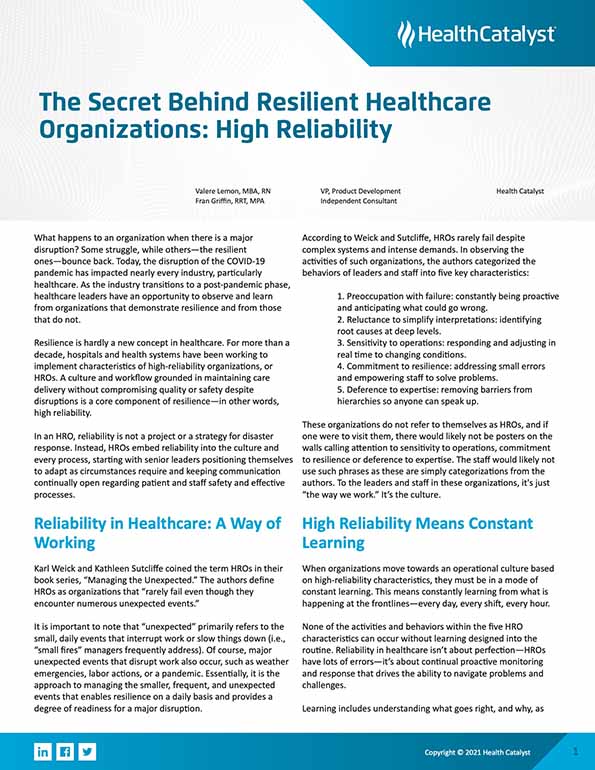Resilience in healthcare means that organizations are continually ready to navigate disruptions of any size without sacrificing quality of care or patient and staff safety. Health systems maintain resilience by embedding the principles of high reliability into their culture, workflows, and processes. These high-reliability organizations (HROs) don’t approach reliability as a short-term project or checklist; rather, they embed the principles into every interaction and action beginning with senior leadership. As a result of a practice, not project, approach to reliability, HROs “rarely fail even though they encounter numerous unexpected events,” as authors Karl Weick and Kathleen Sutcliffe explain in their book series, “Managing the Unexpected.”



What happens to an organization when there is a major disruption? Some struggle, while others—the resilient ones—bounce back. Today, the disruption of the COVID-19 pandemic has impacted nearly every industry, particularly healthcare. As the industry transitions to a post-pandemic phase, healthcare leaders have an opportunity to observe and learn from organizations that demonstrate resilience and from those that do not.
Resilience is hardly a new concept in healthcare. For more than a decade, hospitals and health systems have been working to implement characteristics of high-reliability organizations, or HROs. A culture and workflow grounded in maintaining care delivery without compromising quality or safety despite disruptions is a core component of resilience—in other words, high reliability.
In an HRO, reliability is not a project or a strategy for disaster response. Instead, HROs embed reliability into the culture and every process, starting with senior leaders positioning themselves to adapt as circumstances require and keeping communication continually open regarding patient and staff safety and effective processes.
Karl Weick and Kathleen Sutcliffe coined the term HROs in their book series, “Managing the Unexpected.” The authors define HROs as organizations that “rarely fail even though they encounter numerous unexpected events.”
It is important to note that “unexpected” primarily refers to the small, daily events that interrupt work or slow things down (i.e., “small fires” managers frequently address). Of course, major unexpected events that disrupt work also occur, such as weather emergencies, labor actions, or a pandemic. Essentially, it is the approach to managing the smaller, frequent, and unexpected events that enables resilience on a daily basis and provides a degree of readiness for a major disruption.
According to Weick and Sutcliffe, HROs rarely fail despite complex systems and intense demands. In observing the activities of such organizations, the authors categorized the behaviors of leaders and staff into five key characteristics:
These organizations do not refer to themselves as HROs, and if one were to visit them, there would likely not be posters on the walls calling attention to sensitivity to operations, commitment to resilience or deference to expertise. The staff would likely not use such phrases as these are simply categorizations from the authors. To the leaders and staff in these organizations, it's just “the way we work.” It’s the culture.
When organizations move towards an operational culture based on high-reliability characteristics, they must be in a mode of constant learning. This means constantly learning from what is happening at the frontlines—every day, every shift, every hour.
None of the activities and behaviors within the five HRO characteristics can occur without learning designed into the routine. Reliability in healthcare isn’t about perfection—HROs have lots of errors—it’s about continual proactive monitoring and response that drives the ability to navigate problems and challenges.
Learning includes understanding what goes right, and why, as often as evaluating what goes wrong. The systems that result in adverse events are the same systems that result in positive outcomes, and everything in between. For example, a golfer seeking to improve her game will not succeed by only analyzing what happened on the days where it all went wrong—swings sliced to the side, balls lost in the woods, or water and a disappointing score. It is equally important to analyze the games that were fair (balls on the fairway but not a great score), went well (par score or close), and had surprising successes (hole in one). A golfer needs to understand what went wrong to avoid recurrence and what went right to replicate it. The same is true in healthcare: as much can be learned from an adverse event as from near misses and successes because the same system and processes produced all of those results.
This learning mentality must be part of the daily routine and incorporated into the workflow. It's not just about retrospective analysis for root causes. For example, at the start of every shift, a brief huddle or team briefing provides an opportunity to assess the current status, anticipate potential issues, and set expectations. Repeating the huddle or briefing at the end of the shift is an opportunity to reflect on what went well, what could have been better, and what to communicate to the next shift or incorporate into tomorrow’s work.
The actions and behaviors of leadership at every level determine an organization’s culture.
Leaders and managers build and support resilience through direct and frequent conversations with frontline teams. This is classic “management by walking around” and involves leadership team visibility, accessibility, and transparency. A present and involved healthcare leadership sends the message to staff that their C-suite and managers at every level are concerned about safety and quality and will act on issues.
The key role of leaders and managers is ensuring that team members have the resources and methods necessary to effectively do the work, whether caring directly for patients or supporting other essential functions. Thus, leaders and managers need to learn what is happening at the frontlines and solicit input and ideas directly from team members. Leaders can only remove barriers when they can identify them. As such, leaders and managers must set the expectation for everyone to speak up and actively solicit feedback from staff. Equally important is follow-up—closing the loop sends the message that safety and quality are priorities.
Perceptions about the culture and importance of safety and quality are based on the actions and behaviors of those with whom staff interact the most—their direct supervisors. Some staff may rarely come in direct contact with the C-suite, particularly in a hospital or health care organization where there are multiple shifts and staff who only work on weekends. The reality is that no amount of messaging or rounding from the chief executives will impact the culture if the actions and behaviors are not consistently happening at every management level. Thus, the senior leadership team has a second role in setting expectations and ensuring that actions and behaviors of supervisors at every level support safety and just culture.
Organizations often use periodic assessments, such as validated survey instruments, to obtain deeper insight into staff perceptions and attitudes about resources, staffing, support, comfort with speaking up, and other topics that contribute to the culture. When something goes wrong, the response from leaders and managers influences the culture significantly. Whether it’s a minor error, a near-miss, or a serious adverse event, team members will observe what happens to those involved and how management handles the issue.
In an HRO, staff regularly raise concerns, report errors and events, and suggest ideas—and receive recognition and reward for doing so. Consider the potential for wrong-site surgery: in nearly every case reported to The Joint Commission, someone in the room recognized that something was wrong and was afraid to speak up.
What would happen if a surgical technician was concerned that surgery was about to proceed on the wrong site, spoke up, and turned out to be incorrect? In an HRO, managers would publicly commend the tech for speaking up about the concern because it was the right action. That tech will be more likely to speak up in the future about a concern and potentially prevent harm as will everyone who learns what happened.
A true test of resilience is a major disruption, and COVID-19 has undoubtedly been that. Healthcare organizations working to embed processes and structures around the HRO characteristics likely have found their staff and managers better equipped to adjust and be resilient during the pandemic. These organizations may also have smoother transitions as healthcare learns its way into the post-pandemic world. Why? Because the HRO mentality hasn’t been a project for them—it’s been a journey to transform how they operate every day.
A great example of resilience occurred in 2016 at Orlando Health in Florida in the wake of the Pulse nightclub shooting. The health system worked for several years to transform its structure, operations, and culture towards high-reliability concepts. Then, in the spring of that year, the organization’s Orlando Regional Medical Center dealt with a major disruption when over 40 shooting victims were brought to their emergency department (ED) in one night.
Every shooting victim who was not declared dead on arrival survived. The medical center carried out multiple emergency surgeries through the night and the next morning, then moved forward with scheduled operating room cases, transitioning back to normal operations. Orlando Health’s leadership team’s description of these events contains examples from the five HRO characteristics, although they don’t specifically mention them or high reliability.
The activities and behaviors Weick and Sutcliffe observed and categorized into the five characteristics are all interwoven and interdependent, like the webbing of a large safety net. Consider the nets of trapeze artists: they are large and must stretch across a broad expanse. Never a quick process, it takes time to create the ropes from multiple fibers, then weave them together. The nets must be firmly secured to solid poles or strong support structures and tested to ensure they will hold, such as when the artists drop onto them during practice sessions from lower heights.
The safety net concept applies to resilience in an organization. Daily, deliberate efforts build resilience with small, minor issues and contribute to an organizational net of resilience supported by consistent leadership behaviors. When a major disruption occurs, organizations developing a safety net of resilience and support structures will better position themselves to respond.
There is no simple checklist of to-dos that turns an organization into an HRO. Some organizations describe that they are “doing high reliability” or “implementing deference to expertise,” giving the impression of a project that once completed will mean HRO status has been achieved. Sadly, some such organizations set aside the “project” of reliability when the major disruption of COVID-19 hit. Other organizations recognized that the activities supporting reliability principles—such as preoccupation with failure, sensitivity to operations, and others—were essential for resiliency to the crisis.
An organization cannot simply “become an HRO,” but senior leaders can choose to undertake a transformational journey to emulate organizations that have been identified as such. This means adopting a learning mindset, embedding that mindset into the culture, and using it as an operating principle, not an endpoint. There is no checklist an organization can conquer and call themselves “done” with high reliability.
So how does one know if reliability efforts are succeeding? It won’t be evident by posters on the walls, use of jargon, or the formation of new committees; rather, reliability will be evident in the daily actions, behaviors, and communications of leaders, managers, and staff as they work. Reliability won’t be evident by achieving low rates or zero occurrences of serious adverse events but by frequent reporting and sharing of issues (even when it appears that adverse events have increased), concerns, near misses, successes, and opportunities with clear evidence of follow-up action and communication. Reliability will be evident in the culture and when staff at every level feel that the description of the reliability characteristics mirrors how they work every day. Persistent reflection on these aspects with commitment to make changes based on those reflections help keep organizations on that journey to high-reliability.
Would you like to learn more about this topic? Here are some articles we suggest: